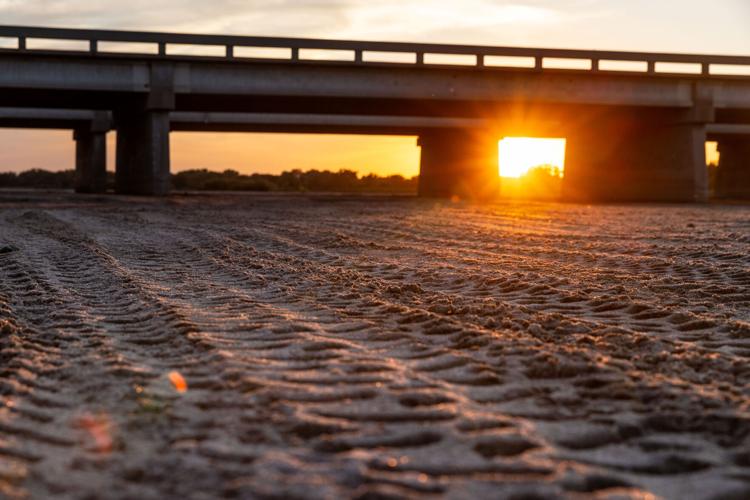Drought drops Platte River to one of its lowest levels in decade in Nebraska
Drought drops Platte River to one of its lowest levels in decade in Nebraska
Stunning images of a virtually dry Platte River near Columbus are yet another reminder of the grip that drought has had on the region.
That stretch of river dropped this week to one of its lowest levels in about a decade, said Jeremy Gehle, water administration division manager at the Nebraska Department of Natural Resources.
He said that Thursday afternoon, the gauge at Duncan, near Columbus, indicated a flow of about 18 cubic feet per second. (A cubic foot, about 7.5 gallons, is about the size of a boxed basketball.) Typically at this time of year, about 25 times more water flows past the gauge there.
Drought has covered parts of the Platte watershed — Nebraska, Colorado and Wyoming — since at least the spring of 2020, according to the National Drought Mitigation Center, which is housed at the University of Nebraska-Lincoln. About three-fourths of Nebraska is in drought as of this week, with only the southeast section drought-free.
Hot, dry, windy conditions earlier this year led to explosive wildfires in Nebraska that burned thousands of acres and contributed to the deaths of two firefighters. Stunted pastures and lack of forage have prompted ranchers to sell off some of their livestock. Dryland crops are suffering and soil moisture is exceedingly short. Irrigation has again been the state’s saving grace.
“We’re at a critical point right now,” Gehle said. “Sections of the Platte River have for all intents and purposes virtually run dry. The big concern is if this drought continues. If reservoirs continue to be drawn down, how much water will be available the next year?”
The river near Columbus is known to run dry during drought, and this is the time of year when flows typically drop off, said John Miller, who oversees gauges along the Platte River for the U.S. Geological Survey.
Flows in the river were similarly low at Duncan in August of 2021 and 2020, he said.
Reduced snow runoff, below-normal precipitation and bouts of extreme heat have all contributed to the low flows, he said. Seasonal improvements usually occur in the fall with the return of rainfall and the end of the growing season.
“While it seems like a scary channel, empty of water, it’s not out of the norm to see these conditions,” he said. “Normally, there’s more water than sand in late October.”
The river is still seeing pulses of water come through, Miller said, either from storms or from occasional releases from Lake McConaughy. Runoff from rains upstream had already caused a slight rise at Duncan on Friday, he said. And a release from Lake McConaughy was working its way downstream and would lead to another short-lived rise.
Conditions this year are significantly better than in 2012, he said. That was the state’s hottest, driest year on record, and rivers were low statewide. The Loup River has had good flows this year, Miller said, and, until recently, so has the Elkhorn River. Both resupply the Platte before it reaches the Omaha metro area.
There have been none of the community restrictions on drinking water like those that occurred in 2012.
While 2012 was Nebraska’s hottest, driest year on record, the statewide average temperature this year has not approached record level. Precipitation is another matter, with the state on pace for a top 10 dry year.
Gannon Rush, a climatologist with the High Plains Regional Climate Center, said weather data underscores the regionally difficult conditions.
Scottsbluff is in the midst of its fifth-warmest July on record, and June-July precipitation at Kingsley Dam on the east side of Lake McConaughy has been the third lowest on record.
And that extreme heat that spiked demand for irrigation this summer? Rush said that in southwest Nebraska, Culbertson recorded 20 days above 100 degrees in June and July and McCook recorded 18.
The U.S. Climate Prediction Center is projecting a hotter and drier than average August in the central part of the country.
“With the heat and dryness returning here soon, it could get worse,” Rush said.

https://omaha.com/news/state-and-regional/drought-drops-platte-river-to-one-of-its-lowest-levels-in-decade-in-nebraska/article_a484a2b0-0f4e-11ed-bed6-a7cda2c8a316.html




Add new comment